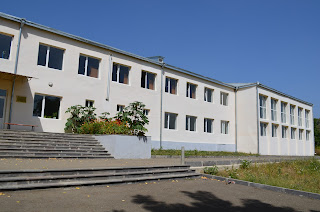The next stop on our way to NK was Noravank Monastery which dates back to 13th century, happily situated in a rocky canyon setting, which makes it one of the favorites among Armenian monasteries.
Noravank means "new monastery" which has new meaning after it has been completely rebuilt. As can be seen all over Armenia, tuff stone is used to rebuild monasteries, which blends in perfectly with the natural settings.
It has two flights of really narrow steps that leads into the main hall of St. Astvatsatsin Church. Because of lack of time and the crowds, none of the tour members attempted the steps, EXCEPT for Baron Khosrov!
There are many khatchkars in the churchyard, however, the most significant one is a 1308 khatchkar by Master Momik, for its fine carving on the entire slab.
A view from the Noravank Monastery complex of the canyon setting.
After lunch we made a welcome change on the agenda, a stop at Karahunj, the Armenian Stonehendge, in the Sisian region.
Referred to also as Zorats Karer, this circular arrangement of stones is believed to be a celestial observatory from the Bronze Age, making it much older than England's Stonehendge.
The trip to NK was pretty eventful - including a flat tire on the bus caused by poor road conditions and the Iran earthquake which we felt during a pit stop in Sisian region. Also, I had forgotten my passport at the hotel reception in Yerevan, which I thought would be a problem when entering NK, however, being with Armenia Fund, it was no problem going thru the border. We also made some stops to buy fruit and wine and vodka from road-side vendors, which we drank on the bus. Some of us suffered the consequences of our actions: too much vodka and bumpy roads don't mix!!!
We stopped at the NK sign at the border for photos, however, there was a puppy where we stopped, and it was so playful that I completely missed the photo op at the border and played with him the entire time. He had a bad eye but was so sweet and playful. I got really emotional playing with him, because he was all alone on the side of the road... It broke my heart. I wished that there was something I could have done.
We arrived in Stepanakert, NK, around 9PM and ended the day.





















































